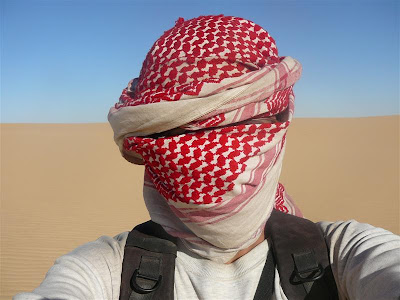The New Valley. That is the name given to a string of oases that stretch westwards in a loop from Cairo south to Luxor. I think the idea behind the name is to imply that this is an area that will be like the Nile to entice people to move there. And enticement they need because apart from sand and date palms there's not much out there. But that's exactly what I was looking for in the form of the White Desert.
At some point a long time ago there must have been a shallow sea covering at least what is today's northern Egypt. Over the millennia the sediments produced by the small organisms built up and formed a layer of chalk. Over time the sea dried up and the land became covered by the sands of the desert, but in places the chalk has resurfaced and, not being a particularly hard substance, has been eroded by the wind. One such place is some 500km west of Cairo close to the Farafra Oasis and has been dubbed the White Desert for obvious reasons. Here the wind has worked like a master sculptor shaping the chalk into many weird and improbable shapes - there are many top-heavy mushroom formations as well as sphinxes, owls, chickens and pretty much anything else your imagination can conjure up. As far as the eye can see the entire landscape is an unending series of surreal shapes and snowscapes (the closest most Egyptians are going to get to snow anyway). Spending the night under the stars in such as place is truly magical. OK, the magic is slightly diminished by knowing that there are some 200 other people dotted around the desert at the same time, but that couldn't be helped, and anyway, in the middle of the night it was easy to imagine being the only person there as there wasn't a single artificial light to be seen.
At some point a long time ago there must have been a shallow sea covering at least what is today's northern Egypt. Over the millennia the sediments produced by the small organisms built up and formed a layer of chalk. Over time the sea dried up and the land became covered by the sands of the desert, but in places the chalk has resurfaced and, not being a particularly hard substance, has been eroded by the wind. One such place is some 500km west of Cairo close to the Farafra Oasis and has been dubbed the White Desert for obvious reasons. Here the wind has worked like a master sculptor shaping the chalk into many weird and improbable shapes - there are many top-heavy mushroom formations as well as sphinxes, owls, chickens and pretty much anything else your imagination can conjure up. As far as the eye can see the entire landscape is an unending series of surreal shapes and snowscapes (the closest most Egyptians are going to get to snow anyway). Spending the night under the stars in such as place is truly magical. OK, the magic is slightly diminished by knowing that there are some 200 other people dotted around the desert at the same time, but that couldn't be helped, and anyway, in the middle of the night it was easy to imagine being the only person there as there wasn't a single artificial light to be seen.

Our guide/driver was a rather unhelpful sod. I suppose that's what happens when you go for the cheapest option, although I still think it's the best strategy because if your expectations are already low and everything goes pear-shaped then it's not such a big deal. Wahid, which was this guy's name, didn't talk much about what we were seeing, the whys and wherefore's, the geological processes or the history. Instead he would talk about money and his numerous foreign girlfriends. The latter subject is rather common amongst young Egyptian men who work with tourists and many have stories of long-term girlfriends abroad and a good number have even been married to foreign women. More often than not these unions do not last, the most common reason cited being "Western women are too free", and in a nutshell that sums up the attitude of Egyptian men in general and (this time) Wahid in particular. He would boast that he would soon be off to Paris to visit one of his girlfriends, and from there it would be on to Switzerland, Italy and then Japan (I think he was getting carried away by this point) and that the tab would be picked up by his many swooning conquests. Now, that in itself didn't bother me as I'm sure many people like a bit of holiday romance and all that, but just out of curiosity I asked him whether his sisters also go out with tourists like he does. "Of course not!" was the reply, "because Egyptian girls like to only do it one or two times a week, whereas Egyptian men three or four times a day." I didn't bother trying to ask him where he got his statistics from but went on to ask him how Egyptian men manage with their wives if there is such a discrepancy between the needs of one party and another. "Easy," he said, "you just hit them until they agree." It's good to see that he's managed to retain his traditional customs despite the exposure to Western decadence.

